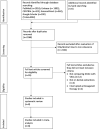Bleeding Outcomes After Dental Extraction in Patients Under Direct-Acting Oral Anticoagulants vs. Vitamin K Antagonists: A Systematic Review and Meta-Analysis
- PMID: 34776943
- PMCID: PMC8585494
- DOI: 10.3389/fphar.2021.702057
Bleeding Outcomes After Dental Extraction in Patients Under Direct-Acting Oral Anticoagulants vs. Vitamin K Antagonists: A Systematic Review and Meta-Analysis
Abstract
Background: The current systematic review aimed to compare bleeding outcomes in dental extraction patients receiving uninterrupted Direct-acting oral anticoagulant (DOAC) or Vitamin K antagonists (VKAs) for various systemic diseases. Methods: PubMed, Embase, ScienceDirect, CENTRAL, and Google Scholar databases were searched for randomized controlled trials, controlled clinical trials, prospective and retrospective cohort studies, and case control studies, conducted on adult patients undergoing dental extraction under uninterrupted DOAC or VKAs therapy and reporting bleeding outcomes. The search was conducted up to March 31, 2021. We pooled data to calculate risk ratios (RR) with 95% confidence intervals (CI) in a random-effects model. Results: Eight studies comparing 539 patients on DOAC therapy and 574 patients on VKAs were included. Meta-analysis indicated a statistically significant lower bleeding risk in patients under DOAC therapy (RR 0.68 95% CI 0.49, 0.95 I2 = 0%). However, on sensitivity analysis, the results were statistically non-significant after exclusion of any of the included studies. On pooled analysis of limited number of studies, we found no statistically significant difference in the risk of bleeding between apixaban (RR 0.85 95% CI 0.45, 1.60 I2 = 0%), rivaroxaban (RR 0.95 95% CI 0.36, 2.48 I2 = 45%), dabigatran (RR 0.49 95% CI 0.19, 1.28 I2 = 5%), edoxaban (RR 0.41 95% CI 0.13, 1.27 I2 = 0%) and VKAs. Conclusion: The results of the first review comparing bleeding outcomes after dental extraction in patients on uninterrupted DOAC or VKA therapy indicates that patients on DOAC may have a reduced risk of hemorrhage. Current evidence is of very low-quality and should be interpreted with caution. Data on individual DOAC is scarce and at this point, the difference in the risk of bleeding between these drugs cannot be elucidated. Further studies with a large sample size shall supplement our conclusion.
Keywords: anticoagulation; hemorrhage; novel oral anticoagulants; oral surgery; warfarin.
Copyright © 2021 Hua, Huang and Huang.
Conflict of interest statement
The authors declare that the research was conducted in the absence of any commercial or financial relationships that could be construed as a potential conflict of interest.
Figures




References
-
- Almutairi A. R., Zhou L., Gellad W. F., Lee J. K., Slack M. K., Martin J. R., et al. (2017). Effectiveness and Safety of Non-vitamin K Antagonist Oral Anticoagulants for Atrial Fibrillation and Venous Thromboembolism: A Systematic Review and Meta-Analyses. Clin. Ther. 39, 1456–e36. 10.1016/j.clinthera.2017.05.358 - DOI - PubMed
-
- Berton F., Costantinides F., Rizzo R., Franco A., Contarin J., Stacchi C., et al. (2019). Should We Fear Direct Oral Anticoagulants More Than Vitamin K Antagonists in Simple Single Tooth Extraction? A Prospective Comparative Study. Clin. Oral Investig. 23, 3183–3192. 10.1007/s00784-018-2739-9 - DOI - PubMed
-
- Brunetti N. D., Tricarico L., Tilz R. R., Heeger C. H., De Gennaro L., Correale M., et al. (2020). Lower Major Bleeding Rates with Direct Oral Anticoagulants in Catheter Ablation of Atrial Fibrillation: an Updated Meta-Analysis of Randomized Controlled Studies. Cardiovasc. Drugs Ther. 34, 209–214. 10.1007/s10557-020-06947-5 - DOI - PubMed
Publication types
LinkOut - more resources
Full Text Sources

